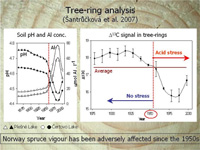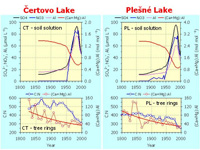BACK
Effect of soil quality on forest vigour
Šantrůčková, H., Šantrůček, J., Šetlík, J., Svoboda, M. and Kopáček, J. 2007. Carbon isotopes in tree rings of Norway spruce exposed to atmospheric pollution. Environ. Sci. Technol. 41: 5778-5782.
Abstract:
The Bohemian Forest was exposed to high levels of sulphur and nitrogen deposition during the last century. The change in acid deposition caused a rapid decline in pH and increase in Al concentrations of soil solutions since the 1950s. A possible negative effect of soil chemistry on growth of Norway spruce tree has been studied using the 13C isotopic signal (Fig. 9) and chemistry of the tree rings. Tree rings were sectioned by decades, and whole wood was analyzed for isotopic composition (Δ13C) and content of Mg, Ca, and Al (Fig. 10). Only those rings that formed after the juvenile effect in early rings were used and trends from the beginning of 20th century were evaluated. The mean Δ13C of the spruce tree rings was 17.6%. The Δ13C did not follow climate changes but had an opposite trend to that of acid depositions and Al concentrations in soil solution, but a similar trend as soil acidification (pH decrease), implying a negative effect of acid deposition and soil acidification on tree physiology. The molar ratio of base cations to Al decreased together with Δ13C.

Fig. 9. Plešné Isotopic tree ring analysis of Norway spruce trees in the Bohemian Forest: modeled soil water chemistry and 13C isotopic signal in the tree rings.
Effect of forest ecosystem acidification and N-saturation on litter composition
Kopáček, J., Cudlín, P., Svoboda, M., Chmelíková, E., Kaňa, J., Picek, T. The composition of Norway spruce litter and foliage in the atmospherically acidified and nitrogen-saturated Bohemian Forest stands, Czech Republic. Submited to Boreal Environment Research.
Litter fall and foliage chemistry were investigated in two mountain, ~150-year-old Norway spruce (Picea abies) stands in the Bohemian Forest, Czech Republic, to assess how their composition reflected high atmospheric acidification and nitrogen-saturation of the area. The two stands, in the catchments of Plešné (PL) and Čertovo (CT) lakes, differed in bedrock (granite vs. mica-schist) and soil chemistry (base saturation of 15% vs. 9%) and higher N-saturation in the CT catchment. Concentrations and fluxes of C, N, P, Ca, Mg, Na, K, Al, Fe, and Mn were examined in six litter fall categories (needles, twigs, bark, lichen, cones, and ”other material”) at 3 and 2 representative plots (differing in elevation) in the PL and CT catchments, respectively, in 2003–2007. Variability in the chemical composition of the total litter fall at individual plots mostly reflected the relative proportion of individual litter categories to the litter pool. Needle litter represented 45–50% of the total litter fall (3.9–5.5 t ha–1 yr–1) and dominated the total litter flux of Mn (69%) and C, N, P, Mg, and K (46–52%). In contrast, the major fluxes of Na, Al, and Fe (46–49%) were associated with “other material” that formed only ~10% of the total litter fall. Litter and foliage had significantly lower Ca and Mg concentrations and Ca:Al ratios, and higher N concentrations and N:Mg ratios in the CT catchment than in the less acidified and N-saturated PL catchment. These symptoms further progressed with elevation in both catchments, corresponding to higher acid deposition at higher elevation. As a result, N, Al, Fe, and P concentrations were significantly higher in most litter categories at high elevation (1310–1330 m) than at low elevation (1045–1130 m) plots. Similarly to the foliage and litter composition, N concentrations were higher, and C:N ratios were lower in the CT than PL understory vegetation and soil litter horizon. The results on tissue composition confirmed higher N availability and more progressed acidification of the CT catchment, indicated by soil composition and higher nitrate leaching.

Fig. 10. Chemical tree ring analysis of Norway spruce trees in the catchments of Čertovo and Plešné lakes in the Bohemian Forest: modeled soil water chemistry and C:N and (Ca+Mg):Al ratios in the tree rings.